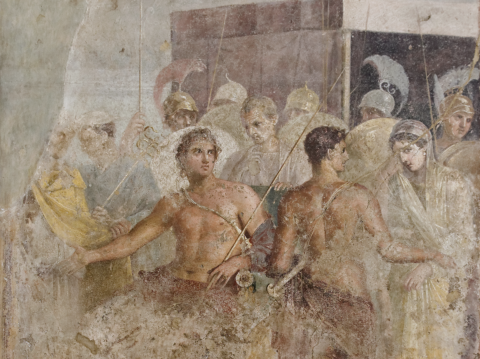Debra Trusty
April 15, 2018
Troy: Fall of a City is a joint effort by Netflix and the BBC to repackage the Trojan War story as the next season of Game of Thrones. Producers David Farr, Derek Wax, and Christopher Aird didn’t have dig too deep to find the material they needed within the ancient myth: blood-thirsty kings, violent battle scenes, forbidden love, and powerful beings flying down from the sky. The Epic Cycle has it all and, since Troy (2004, starring Brad Pitt) hit the theaters nearly 15 years ago, perhaps we were due for another rendering.
Released in the U.S. on April 6th, the 8-episode series is ambitious, to say the least. Its writers wanted to tell the story of the fall of the mythological city of Troy and this, perhaps, is a bit hubristic. After all, Homer’s Iliad (which consists of over 15,000 lines of poetry and would have taken over 15 hours to perform) only covers the “wrath of Achilles,” roughly a 40-day period near the end of the 10-year war. But Troy: Fall of a City has restricted its plot substantially. Rather than including as many heroes and all of the scenes from the Iliad as they could, the writers chose to focus on Paris (aka Alexander, played by Louis Hunter) and Helen (Bella Dayne).
The result is a satisfying and untraditional character arc for Paris that I won’t ruin here. King Priam (David Threlfall), his wife Hecuba (Frances O’Connor), and their son Hector (Tom Weston-Jones) make regular appearances, as do Menelaus (Jonas Armstrong), Agamemnon (Johnny Harris), and Odysseus (Joseph Mawle). Achilles (David Gyasi) is not as major of a character as you would expect, and this may be a bit of a surprise, but it conforms to the restrictions of a mini-series. Book 1 of the Iliad does not actually begin until episode 4 (“Spoils of War”) and is over by the middle of episode 7 (“12 days”).

I will admit I was worried that the inclusion of the gods would be too fantastical or distracting, but their minimal use was effective. Zeus (played by Hakeem Kae-Kazim, a “controversial” choice for some), Aphrodite (who seems to have stepped out of a Botticelli painting), Hera (complete with an outfit of peacock feathers), Athena, and Hermes all participate. Artemis even makes an appearance, though Apollo is absent. I found myself missing Thetis; she would have been a welcome addition, but Achilles is not the focus of this retelling. The gods are not there to emphasize the severity of war and present a stark contrast between the casual life of immortals and tragic lives of humans, as in the Iliad, but are simply just push the plot along. We need a reason for Paris to whisk Helen away and Zeus describes the contest for the golden apple as “just a game” when he actually has a bigger plan in mind. The gods are instigators; they treat humans as pawns, though not nearly to the extent seen in the Iliad.
This is not a series that pulls its punches or avoids controversy. Sexuality and graphic content are fair game, but it is the casting that has caused the greatest stir. The BBC/Netflix has been accused of “blackwashing” the cast by choosing black actors to depict Zeus and Achilles, among other characters. Meanwhile, in the series itself, the characters themselves seem color blind; racism isn’t visible on the streets of Troy. Sure, the Trojans had bigger issues to worry about (like the Greek forces at their doors), but the series’ silence on race speaks to modern hopes for a post-racial society. Race simply wasn’t included as a part of the script, as Farr made clear in an interview with Variety: “We are not claiming that Achilles was actually Ethiopian... It is simply a casting decision. Whoever came and inhabited the spirit of the characters best we decided to cast." While colorblindness is not without its own problems, those who argue that the casting was “un-Homeric” need to take a serious step back. After all, no one seems to be complaining about the pale red-heads who are scattered throughout the city streets.
As for sexuality, there are only three romantic couples present: Paris and Helen, Hector and Andromache, and Patroclus and Achilles. The former two are very conventional with Paris and Helen’s relationship at the center of it all. The relationship between Achilles and Patroclus, though not described by Homer, is consistent with later ancient sources. What Troy: Fall of a City adds is their relationship with Briseis. The threesome on the beach, while sexually liberated and non-traditional (both in the ancient sources and modern concepts of love), feels forced and disingenuous. After their love scene (or lack-thereof), we immediately revert to ancient patriarchal views of women as belongings: Achilles calls her “my woman” and “my girl” and refuses to fight unless they can supply him with a cause that will bring glory (all very Homeric). He isn’t focused on getting Briseis back. Briseis does not seem to be a symbol of sincere love and affection, merely a means to sexual gratification. Furthermore, Achilles hasn’t had much screen time at this point (and won’t), so it is hard to feel emotionally attached to him and understand his motivations. Perhaps there is genuine passion there, but we don’t see it on the screen.

This retelling of the Trojan War makes itself fiercely relevant in today’s age of pussyhats and #MeToo through its other depictions of gender. In Troy: Fall of a City, the king and queen rule the city equally. Their thrones are the same size (unlike those in Sparta) and this attitude is a welcome sight for Helen, who is frequently represented as a caged bird. Her outfits usually involve elaborate feathers and her pet birds squawk from their cages until they are released at the same time as Helen’s abduction. When in Troy she justifies her flight from Sparta: “I think. I feel. And I am here because I want to be.” Helen is not a possession. Nevertheless, Troy is not the egalitarian oasis that it seems. Too often the women often have a solution or the correct response to an event and then men don’t listen. It’s not just Cassandra who is ignored, but all the women. By pitting sensible women against prideful men, the series exposes the shallowness of Troy’s supposed gender equality-- the very thing that would have saved them. Perhaps a cautionary tale ripped straight from Euripides’ stage, the irony is thick as the series ends with an utterly heartbreaking view of the true victims of war: the women.
It may seem minor, but I was happy to see that Netflix and BBC rightly recognized their source material in the opening credits: “Inspired by Homer and Greek myths.” The last three words were a welcome sight for me. Pop culture has credited the entire Epic Cycle, from the Judgement of Paris to Odysseus’ slaughter of the suitors, to Homer for far too long (yes, I’m looking at you, Wolfgang Petersen). As we know, Homer’s Iliad is just a part of the Epic Cycle. Furthermore, there is no standardized, authoritative, or codified view of Trojan War from ancient Greece and Rome. Homer (if such a person existed) is just one poet among many who gave his (or her) own version of the story.
Plenty of authors played around with the world-famous epic: Aeschylus, Sophocles, and Euripides in ancient Greece, Virgil and Ovid in Rome (to name just a few). The story was always changing...and it has never stopped changing. Chaucer, Marlowe, Shakespeare, Goeth, Yeats, but also Robert Wise, Wolfgang Petersen, and now Farr et al. Homer (again, if he/she existed) would be proud of that because it preserves the essence of the oral tradition. What this leaves us with is not just an opportunity to recreate ancient society, but also a chance to reflect on our own societal values: who we are as an audience and who we want to be.
Sure, there are plenty of missed opportunities. I would have loved to see Hera seduce Zeus in order to gain control of the battlefield. The weighing of Hector’s and Achilles’ fates could have added an interesting element of drama. Armor, columns, wall paintings, thrones, diadems, and pottery all clearly took inspiration from archaeological sources, although not always the right ones. The purpose of these different objects is to show how Troy is geographically located at the intersections of some very influential cultures. Yet the set designers make mistakes, too. It was a bit painful to see Greek-influenced pottery that was anachronistic and unauthentic in design. Pottery and lamp styles are from a range of time periods (Bronze Age through Roman period). This isn’t the same as changing a plot to fit time constraints or adding elements that the audience might find more entertaining or relatable. It felt as if the set designers didn’t want to fully engage in the rich cultural material of Greece and Asia Minor, but I’m an archaeologist, so of course I’ll find it irksome.
My only major complaint is that there is a severe shortage of battle scenes. If we’re basing a series on the Trojan War, we should witness the war. Yet we don’t see Homer’s grand aristeias, nor are there graphic views viscera pouring out on the ground as swords cut through warriors’ chests (though we do get to see Achilles’ spear protrude from the mouth of a Trojan, à la Idomeneus in Book 16). Battles are smaller than they should be and the camera often deliberately avoids the action, showing characters running off to the battlefield while the shot remains focused on Achilles or Priam. Sometimes all you see is the aftermath of a battle. Too often, the battles are only between a handful of warriors, with the rest of the scene empty. This is painful when you consider the money spent on grand CGI recreations of a very large ancient city. Large-scale battle scenes are expensive and difficult to choreograph, but the omission is pretty glaring.
This is a series, however, that requires us to put these concerns aside in order to enjoy the ride. There are still plenty of moments to celebrate (my personal favorite was a direct quote from Euripides’ Iphigenia in Aulis). While a few more “Easter eggs” would have been nice, we need to remember that, just like Jurassic Park wasn’t written for paleontologists, Troy: Fall of a City wasn’t written for people who want a line-by-line reproduction of the Iliad. My message, therefore, is to go into this series with an open mind and an eager spirit. After all, this story had been retold thousands of times over the course of thousands of years. What’s one more?
Header Image: Achilles cedes Briseis to Agamemnon, from the House of the Tragic Poet in Pompeii, fresco, 1st century CE (Naples National Archaeological Museum. Image via Wikimedia and is in the Public Domain)
Authors


